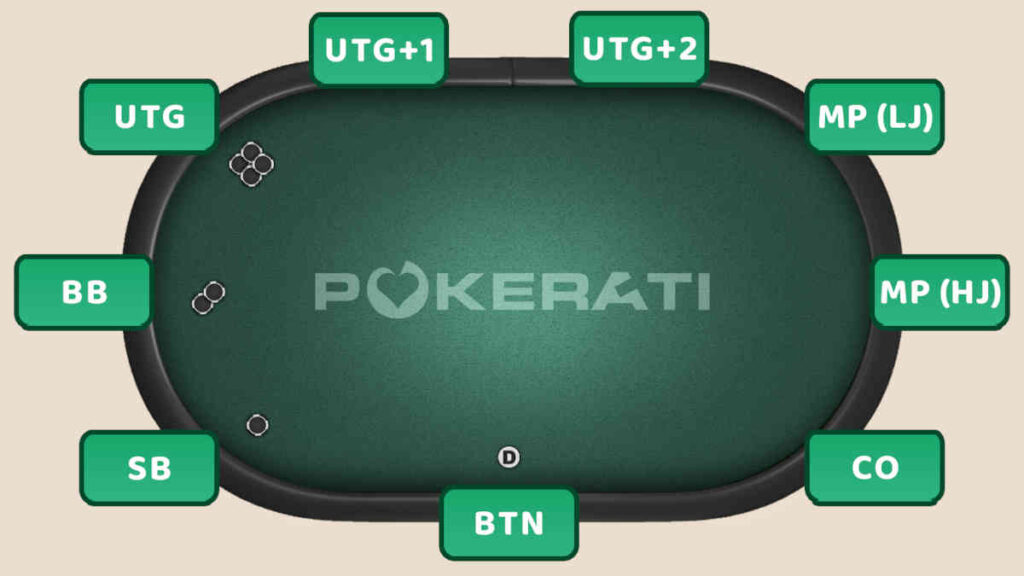Poker position is one of the most important strategic elements of poker. Yet, it is one that amateur poker players often neglect altogether.
If you want to be a successful poker player, you will need to understand poker positions and how they impact poker strategy.
Whether you are seated in one of the blinds, on the dealer button, or anywhere in the middle, you must learn how to handle yourself and what poker hands to play.
In this guide to poker positions, we will teach you what poker position is, why it matters, and how you should adjust your overall strategy in different positions.
Let’s start with the basics!
What Is Position in Poker?
So, what exactly is position in poker, and how do you determine it? In the simplest of terms, poker position is your position at the table relative to the dealer button.
So, regardless of whether you are seated in the one seat or the nine seat, you will get to play every position at the table once per orbit.
The dealer button moves one spot to the left for every new hand. Each time the dealer button is moved, every player at the table changes position.
To make things perfectly fair, the starting positions in any poker game are determined by a random draw. In each orbit, each player gets to play exactly one hand in each of the possible positions.
Understanding the Different Poker Positions
The number of positions in any poker game depends on the total number of seats in that game. A six-handed poker game has a total of six positions, while a full-ring poker game has a total of nine positions.
Note that the nine full-ring poker positions include all the positions that are possible in shorter-handed games as well.
Each position at the table has a specific name, which you can use to identify it and discuss hands with other players.
Starting from worst to best, the positions at the poker table are:
- Small Blind (SB)
- Big Blind (BB)
- Under the Gun (UTG)
- Under the Gun +1 (UTG1)
- Under the Gun +2 (UTG2)
- Lojack (LJ)
- Hijack (HJ)
- Cutoff (CO)
- Dealer Button (D or BTN)
Two players in each hand must post the small and the big blind. The blind positions are the worst positions at the table, as they play first on every postflop betting street, and they are forced to put chips into the pot before the cards are dealt.
The next three positions, UTG, UTG1, and UTG2, are called early positions. Early positions are some of the least favorable at the table, as they are forced to play from out of position against most of the players at the table.
The LJ and HJ are the middle positions at full-ring poker tables. These positions are more favorable than early positions but less favorable than late positions.
Late poker positions are CO and BTN. The BTN, in particular, has a massive positional advantage over the rest of the table, as it always gets to play last on each postflop betting street, no matter what.
Importance of Position in Poker
Position is one of the most powerful tools you have in your strategic arsenal in Texas Hold’em. Being in position over your opponents puts you into a significant advantage for several reasons.
Let’s briefly dive into those reasons and explain each one in the simplest way possible.
Preflop Advantage
Your positional advantage starts before the flop. In this first betting round, players in late position get to play last before the blinds. This puts them in a prime position to steal the blinds with a wide range of hands.
For example, imagine you are dealt two offsuit picture cards in early position. If you make a raise, you have to get through eight other players. Even if they only re-raised you with just 5% of their starting hands, that would still mean you get re-raised 40% of the time.
On the other hand, raising the same hand from the dealer button means you only need to get through the small blind and the big blind.
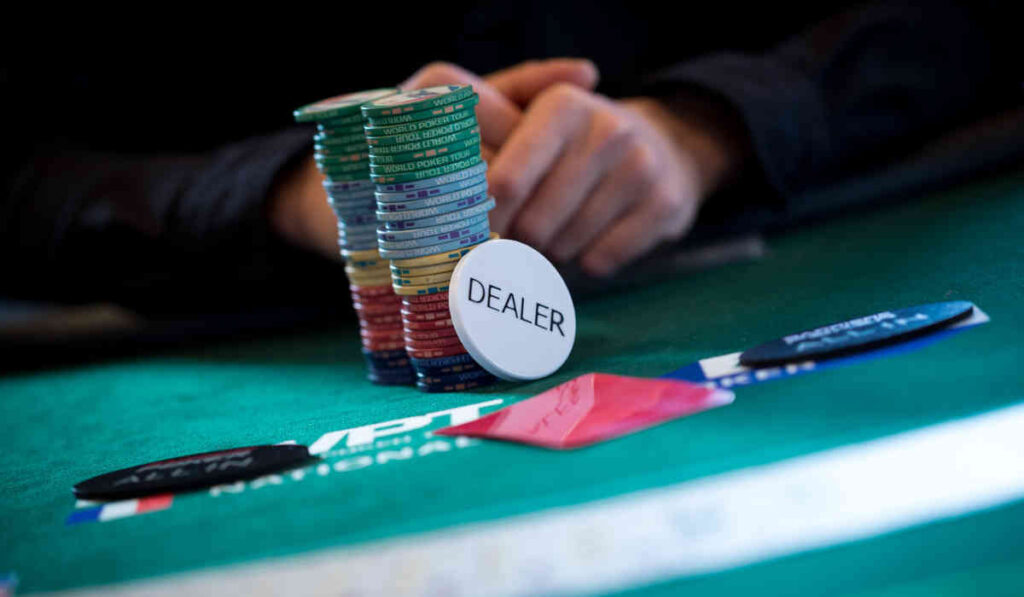
If they fold, you get to win the blinds and antes. If they call, you get to play the pot in position. If they re-raise, you can call with a wide range, as you will have the last say on every future betting street.
Informational Advantage
Being in position means you get information from every other player at the table, while they don’t get any information on you.
For example, imagine calling an early position raise on the dealer button. Once the flop is dealt, your opponent will have to make a bet or check first, and you get to go last.
This means you will see how they act on their hand first before making your decision. This is a luxury they won’t have.
This informational advantage can give you a massive edge in pots and allow you to win many pots you would not have won if you were out of position.
In technical terms, you get to “over-realize your equity.” In simple terms, you get to win more chips than you “should.”
Pot Control
Tying in with the previous point, positional advantage allows you to control the size of the pot when you choose to do so.
For example, imagine you re-raise before the flop and get one caller. Once the flop is dealt and your opponent checks, you get to decide whether to bet or not.
If you have a hand with medium showdown value, you may choose to check for the time being and prevent the pot from getting too big.
If you were out of position and checked in the same spot, your opponent would have the option to bet, thus taking away your ability to control the size of the pot.
This idea of pot control also comes into play on turns and rivers. After c-betting the turn, you get to check back the turn and control the pot. On the river, you can choose which hands are worth a value bet and which you are content to simply check back and show down.
Play More Hands
Ultimately,a better position simply allows you to play more hands. Since you have fewer players to play against, will have more information, and can control the size of the pot, you get to play more hands preflop.
In very soft and passive games, some good players raise up to 70% of their buttons or even more. That’s simply because their opponents don’t know how to play back from out of position.
Even when playing against very competent players at deeper stacks, you should still be playing well over 35% of all starting card combinations.
While playing so many hands will require you to navigate many postflop situations, the positional advantage you have will allow you to do so more accurately.
Playing Each Poker Position
Now that we have described the advantages that later positions can bring you, let’s talk about the exact strategies you should apply in playing from each of the nine positions at the poker table.
Under the Gun (UTG)
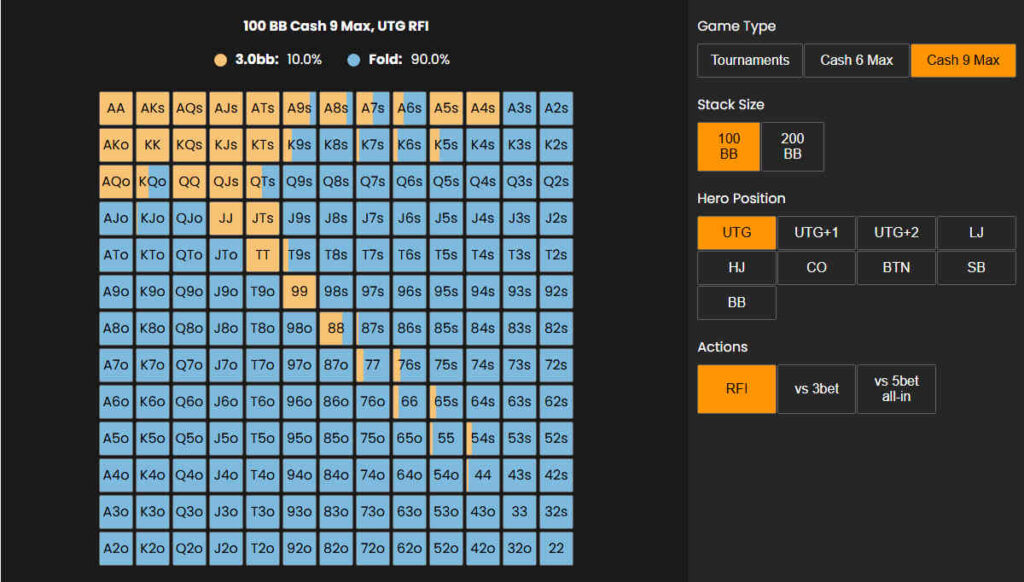
UTG is the first position to play before the flop, which is why you have to play the tightest opening range from this position.
Typically speaking, you should be playing around 10% of your starting hands from UTG, and always coming in for a raise when you do play.
While just calling the blind (limping) may seem tempting, playing all your hands as raises is a superior strategy from all positions.
Stick to playing the best hands mixed in with a few middle pairs and suited connectors from UTG, and avoid getting involved with hands that are easily dominated.
Under the Gun +1 (UTG1)
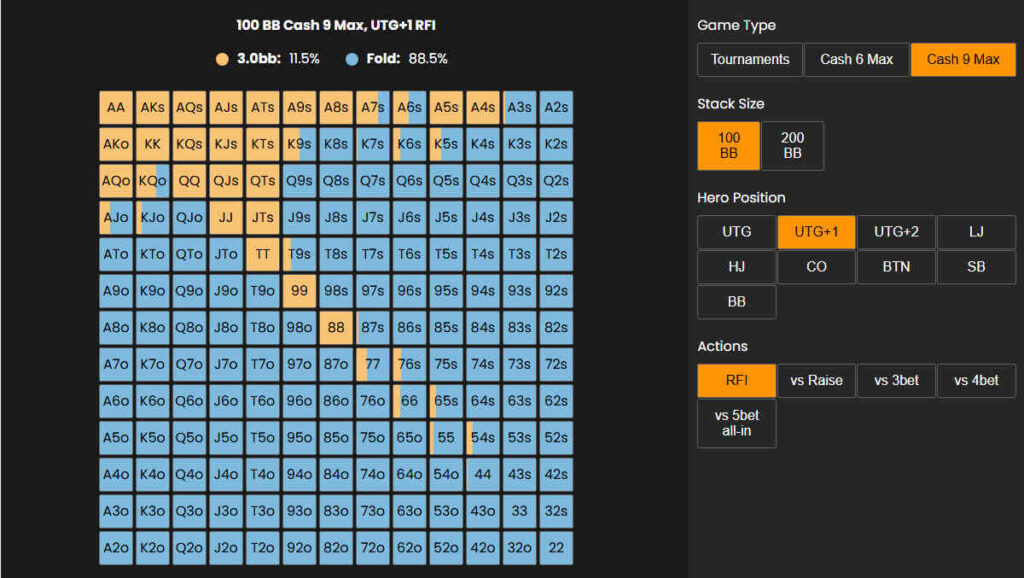
The next poker position is UTG1. Much like UTG, this position must play a tight opening range so as to avoid getting exploited by players in later positions.
Compared to UTG, you get to expand your range slightly, but you should usually play a very similar opening range to UTG.
In most games, you will want to raise about 12% of starting hand combos from UTG1, and fold everything else to avoid getting in unprofitable spots.
Under the Gun +2 (UTG2)
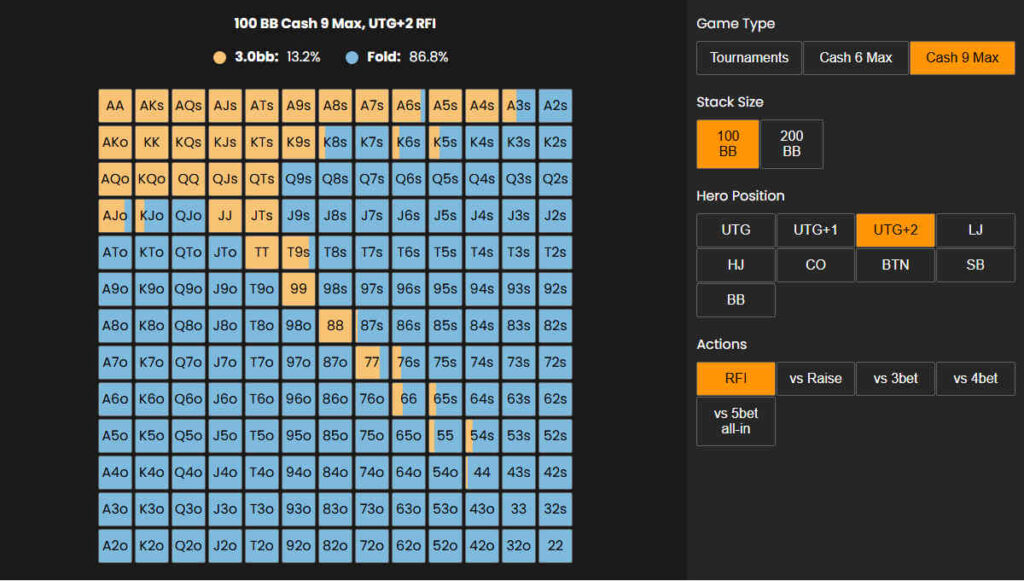
UTG2 is the last of the three early positions, and your poker strategy here should not be too different.
A quick look at the preflop raising charts will tell you that opening about 13 to 14% of hands from UTG2 is the way to go.
Having a couple of players fold in front of you allows you to start playing hands like J9s and KQ, but you should still be folding cards like QT or 87s due to your positional disadvantage.
Lojack (LJ)

Transitioning into the middle position allows you to start opening up your range. Our raising charts indicate you can play around 16% of starting hands from the first middle position.
The Lojack opening range includes all suited Aces and suited connectors down to 76s. Still be super careful with raising any offsuit hands other than the few best ones like AJ and KQ.
If you do face a raise from one of the early positions, play a very tight range and always go for the re-raise. Calling in LJ opens up room for players in later position to come along with a discount or re-raise themselves and push you out of the pot.
Hijack (HJ)

We are starting to get into the later position territory, and that means you can start contemplating stealing blinds and applying some extra aggression.
The average HJ opening range should include about 20% of all hands, which includes offsuit hands like QJ and suited hands like 54s.
You should still not be considering playing any trashy hands or calling raises from early positions. Like in the LJ, always play a 3-bet or fold strategy when you find yourself in the HJ.
Cutoff (CO)

The Cutoff is one of the best positions at the poker table, and that’s why you can play quite a wide range of hands when you are in this poker position.
The CO opening range includes over 25% of starting hands, including all pocket pairs, basically all suited connectors, all offsuit Broadways, and some suited gap connectors like 75s.
If you are playing at a particularly tight table, and the played on the Button is not aggressive, you can get away with raising even more, as winning the ultimate position can be quite profitable.
Make sure not to go too far with this, and play even tighter if the player to your left is especially sticky and likely to call your raises a lot.
Dealer Button (D or BTN)
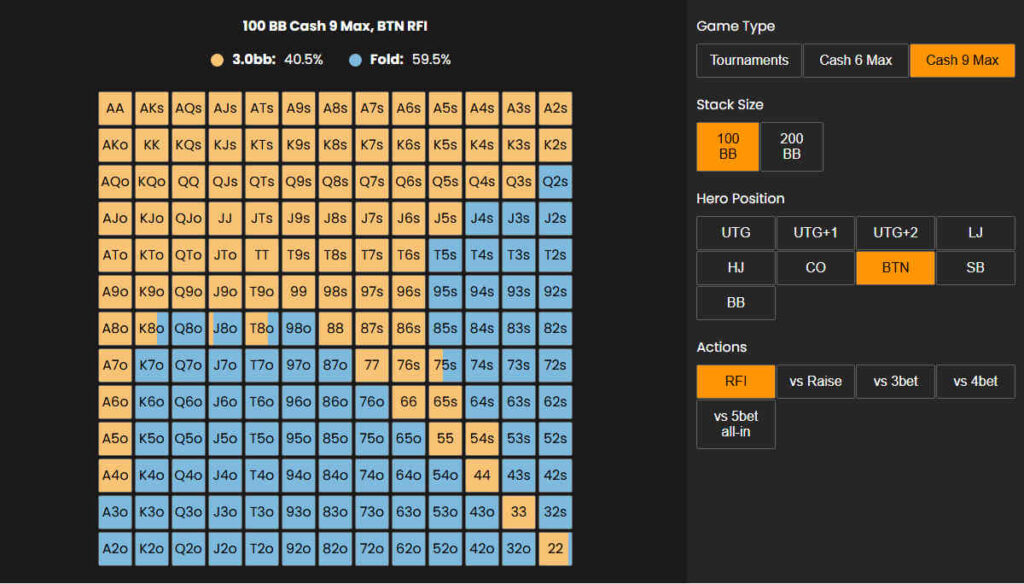
The Dealer Button is the ultimate position at the poker table and one that we all wish we had for every single hand.
Whenever you are seated on the BTN, you should play as many hands as you can get away with. An average of 40% is a good baseline for most games.
Most suited hands with any connectivity or a high card like a King are good enough for a raise, as are all offsuit Aces and some offsuit connectors.
The Dealer also allows you to re-raise earlier position raises quite liberally in order to push out the blinds or call with some hands and see some flops in position when deep-stacked.
The Button gives you the most room for creative and fancy play, as the positional advantage you gain trumps most other factors.
Small Blind (SB)
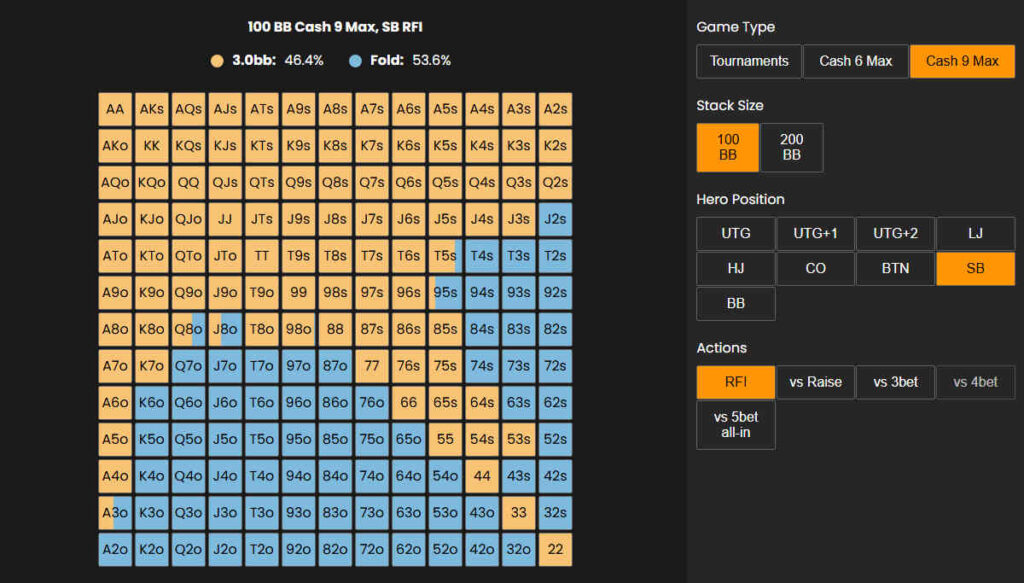
The Small Blind is the only position at the poker table that allows you to profitably limp some hands. Since you are getting a discount, you can simply complete the blind with some weaker suited hands and mix in some strong hands as traps in your limping range.
In the rare situations when all players do fold to you, however, you should still often raise. Overall, you can play about 50% of all your starting hands in unopened pots. How aggressive you get depends mostly on the Big Blind’s tendencies.
When facing a raise from other players, you should usually play a 3-bet or fold strategy. You can 3-bet more aggressively against late-position openers, who are likely to have a wide range. Size up your 3-bets in order to get more folds and negate some of the positional disadvantages.
Big Blind (BB)
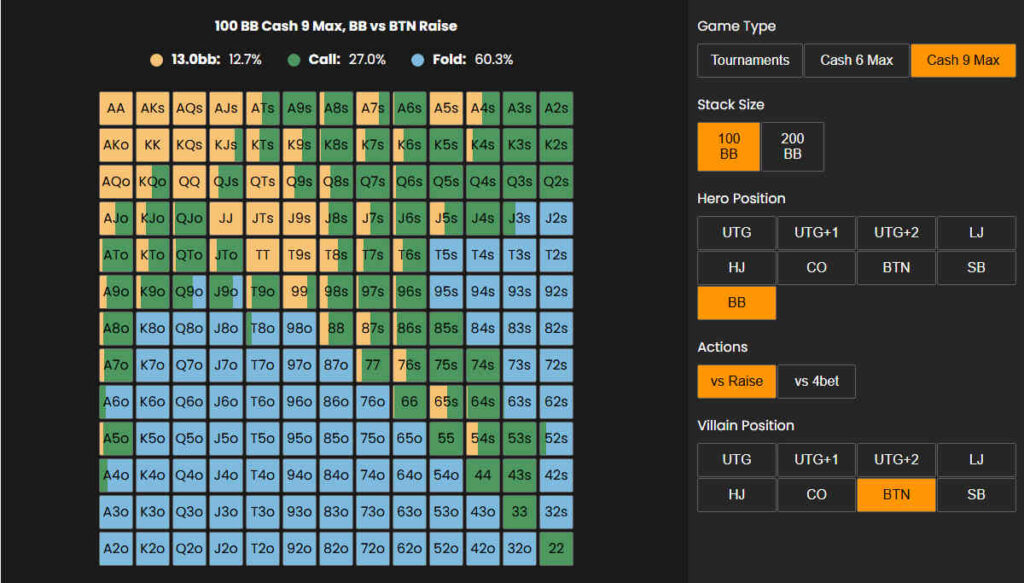
The Big Blind is the one position at the table that’s all about the defense. While we recommend re-raising against raises in most other positions, just calling a raise in the big blind is perfectly fine.
This is especially true in tournament poker, where raises tend to be small, and the pot odds you are getting laid can be very good.
In either case, your defending ranges will depend on how aggressive your opponents are and how capable you think they are after the flop.
Remember that you will mostly play from out of position postflop, so adjust your ranges accordingly and make sure to fold a lot when facing 3x or bigger raises.
Use Poker Position to Your Advantage
Poker players often fall into an autoplay mode and stop paying attention to factors like position and stack sizes.
However, poker position is a critical element of your poker strategy and one you should always be fully aware of.
Before you start playing your next poker session, make sure to look over our starting hand charts for every poker position and learn the baseline strategies for each seat at the table.
This way, you will know which hands to play and which to fold in different situations, and your bottom line will thank you for it.
